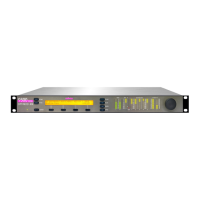5-2
TROUBLESHOOTING ORBAN MODEL 9300
Excessively Low Positive Peak Modulation
The polarity of the 9300’s active output might be reversed. You can test this by edit-
ing the P
OLARITY field in the active System Preset.
You may have not allowed enough peak headroom in the 9300’s output level set-
ting. Achieving 125% modulation requires 2 dB of headroom. To achieve 125% posi-
tive modulation, you must therefore set the AO
X OUT control to +18 dBu or lower, or
the DO
OUT control to –2.0 dBfs or lower.
If you have a tube-type transmitter with high-level plate modulation, the modulator
tubes may be flat.
Audible Distortion On-Air
Make sure that the problem can be observed on more than one receiver and at sev-
eral locations. Multipath distortion at the monitoring site can be mistaken for real
distortion (and will also cause falsely high modulation readings).
Verify that the source material at the 9300's audio inputs is clean. Heavy processing
can exaggerate even slightly distorted material, pushing it over the edge into unac-
ceptability.
The subjective adjustments available to the user have enough range to cause audi-
ble distortion at their extreme settings. Many controls can cause distortion, includ-
ing M
ULTIBAND CLIPPING and FINAL CLIP DRIVE. Setting the LESS-MORE control beyond
“9” will cause audible distortion of some program material with all but the Classical
and Protect presets. Further, the “Loud” family of presets can sometimes cause au-
dible distortion with certain program material; this is the price to be paid for “com-
petitive” loudness as it is defined in certain markets.
If you are using analog inputs, the peak input level must not exceed +27 dBu or the
9300's A/D converter will clip and distort.
Unlike earlier digital Optimods, there is no input peak level adjustment
for the A/D converter. Instead, we have provided adequate headroom for
virtually any plant. This is possible because the A/D converter in the 9300
has higher dynamic range than older designs, so we could eliminate a
control that was frequently misadjusted without compromising the
9300’s noise level.
If you are using an external processor ahead of the 9300, be sure it is not clipping or
otherwise causing problems.
The 9300's highly processed output puts great demands on transmitter performance
Some transmitters cannot handle the very high average power in the 9300's output
Section 1 discusses this in detail
The distortion of tube-type transmitters will increase substantially as the tubes go
flat with use The first thing to go is asymmetrical positive peak capability, so if it is
impractical to replace the modulator tubes at this time, reduce the setting of the
9300 P
OSITIVE PEAK control until the transmitter no longer compresses the peaks. In-

